英语数量词归类大全
- 格式:doc
- 大小:36.00 KB
- 文档页数:3
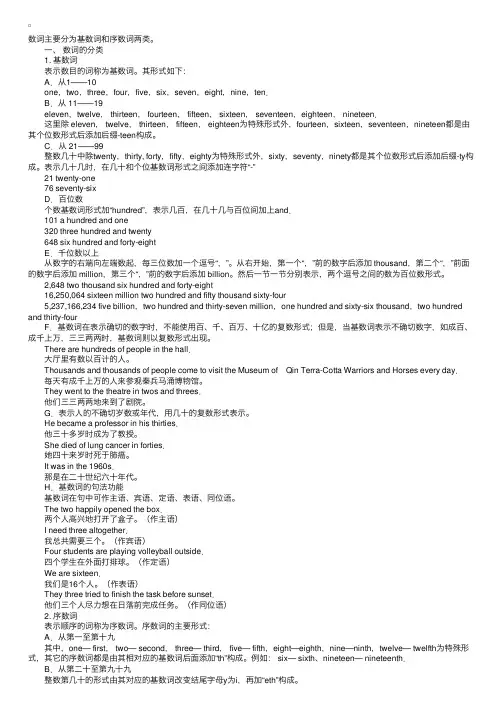
数词主要分为基数词和序数词两类。
⼀、数词的分类 1. 基数词 表⽰数⽬的词称为基数词。
其形式如下: A.从1——10 one,two,three,four,five,six,seven,eight,nine,ten. B.从 11——19 eleven,twelve, thirteen, fourteen, fifteen, sixteen, seventeen,eighteen, nineteen. 这⾥除 eleven, twelve, thirteen, fifteen, eighteen为特殊形式外,fourteen,sixteen,seventeen,nineteen都是由其个位数形式后添加后缀-teen构成。
C.从 21——99 整数⼏⼗中除twenty,thirty, forty,fifty,eighty为特殊形式外,sixty,seventy,ninety都是其个位数形式后添加后缀-ty构成。
表⽰⼏⼗⼏时,在⼏⼗和个位基数词形式之间添加连字符“-” 21 twenty-one 76 seventy-six D.百位数 个数基数词形式加“hundred”,表⽰⼏百,在⼏⼗⼏与百位间加上and. 101 a hundred and one 320 three hundred and twenty 648 six hundred and forty-eight E.千位数以上 从数字的右端向左端数起,每三位数加⼀个逗号“,”。
从右开始,第⼀个“,”前的数字后添加 thousand,第⼆个“,”前⾯的数字后添加 million,第三个“,”前的数字后添加 billion。
然后⼀节⼀节分别表⽰,两个逗号之间的数为百位数形式。
2,648 two thousand six hundred and forty-eight 16,250,064 sixteen million two hundred and fifty thousand sixty-four 5,237,166,234 five billion,two hundred and thirty-seven million,one hundred and sixty-six thousand,two hundred and thirty-four F.基数词在表⽰确切的数字时,不能使⽤百、千、百万、⼗亿的复数形式;但是,当基数词表⽰不确切数字,如成百、成千上万,三三两两时,基数词则以复数形式出现。

英语数量词大全英语数量词大全是指用于表示数量的词汇。
在英语中,数量词分为基数词和序数词两种类型。
基数词用来表示数量的具体数目,而序数词则表示事物的顺序或排列次序。
接下来,我将为您详细介绍英语中常见的数量词,并且给出一些例句,以便您更好地理解和运用。
1. 基数词(Cardinal Numbers)基数词用来表示数量的具体数目,是最基本的数量词。
下面是从1到20的基数词表达方式:one (1), two (2), three (3), four (4), five (5), six (6), seven (7), eight (8), nine (9), ten (10),eleven (11), twelve (12), thirteen (13), fourteen (14), fifteen (15), sixteen (16), seventeen (17), eighteen (18), nineteen (19), twenty (20).例句:- I have two cats.(我有两只猫。
)- There are thirteen students in the classroom.(教室里有十三名学生。
)2. 序数词(Ordinal Numbers)序数词用来表示事物的顺序或排列次序。
以下是从1到20的序数词表达方式:first (第一), second (第二), third (第三), fourth (第四), fifth (第五), sixth (第六), seventh (第七), eighth (第八), ninth (第九), tenth (第十),eleventh (第十一), twelfth (第十二), thirteenth (第十三), fourteenth (第十四), fifteenth (第十五), sixteenth (第十六), seventeenth (第十七), eighteenth (第十八), nineteenth (第十九), twentieth (第二十).例句:- This is the third time I have been to Paris.(这是我第三次去巴黎。
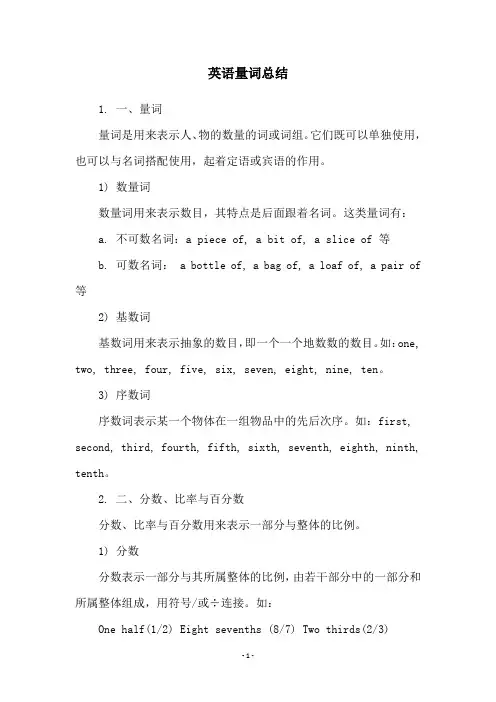
英语量词总结1. 一、量词量词是用来表示人、物的数量的词或词组。
它们既可以单独使用,也可以与名词搭配使用,起着定语或宾语的作用。
1) 数量词数量词用来表示数目,其特点是后面跟着名词。
这类量词有:a. 不可数名词:a piece of, a bit of, a slice of 等b. 可数名词: a bottle of, a bag of, a loaf of, a pair of 等2) 基数词基数词用来表示抽象的数目,即一个一个地数数的数目。
如:one, two, three, four, five, six, seven, eight, nine, ten。
3) 序数词序数词表示某一个物体在一组物品中的先后次序。
如:first, second, third, fourth, fifth, sixth, seventh, eighth, ninth, tenth。
2. 二、分数、比率与百分数分数、比率与百分数用来表示一部分与整体的比例。
1) 分数分数表示一部分与其所属整体的比例,由若干部分中的一部分和所属整体组成,用符号/或÷连接。
如:One half(1/2) Eight sevenths (8/7) Two thirds(2/3)2) 比率比率是指两种或两种以上的量,表示其中一部分与其余各部分之间的比例的量。
它以a:b或a/b的形式来表示,其中,a和b可以是数字,单词或短语。
如:Four:nine (4:9) Two-thirds:one-third (2/3:1/3) Books:pens (books:pens)3) 百分数百分数是指用百分率表示法来表示一部分与整体的比例,它由百分符号“%”和基数词组成。
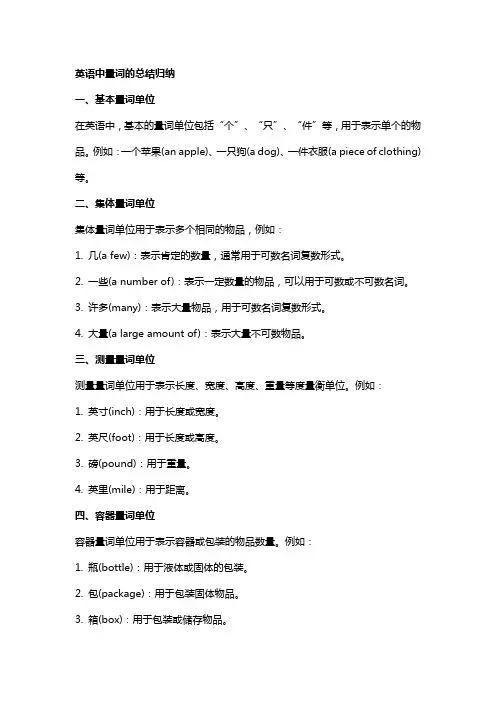
英语中量词的总结归纳一、基本量词单位在英语中,基本的量词单位包括“个”、“只”、“件”等,用于表示单个的物品。
例如:一个苹果(an apple)、一只狗(a dog)、一件衣服(a piece of clothing)等。
二、集体量词单位集体量词单位用于表示多个相同的物品,例如:1. 几(a few):表示肯定的数量,通常用于可数名词复数形式。
2. 一些(a number of):表示一定数量的物品,可以用于可数或不可数名词。
3. 许多(many):表示大量物品,用于可数名词复数形式。
4. 大量(a large amount of):表示大量不可数物品。
三、测量量词单位测量量词单位用于表示长度、宽度、高度、重量等度量衡单位。
例如:1. 英寸(inch):用于长度或宽度。
2. 英尺(foot):用于长度或高度。
3. 磅(pound):用于重量。
4. 英里(mile):用于距离。
四、容器量词单位容器量词单位用于表示容器或包装的物品数量。
例如:1. 瓶(bottle):用于液体或固体的包装。
2. 包(package):用于包装固体物品。
3. 箱(box):用于包装或储存物品。
4. 桶(bucket):用于液体或固体的储存或包装。
五、抽象量词单位抽象量词单位用于表示抽象的概念或属性。
例如:1. 种(kind):表示种类,用于描述不同的事物。
2. 点(point):表示小的数量或程度,常用于描述优点、缺点等。
3. 片(piece):用于描述部分的数量,通常与不可数名词连用。
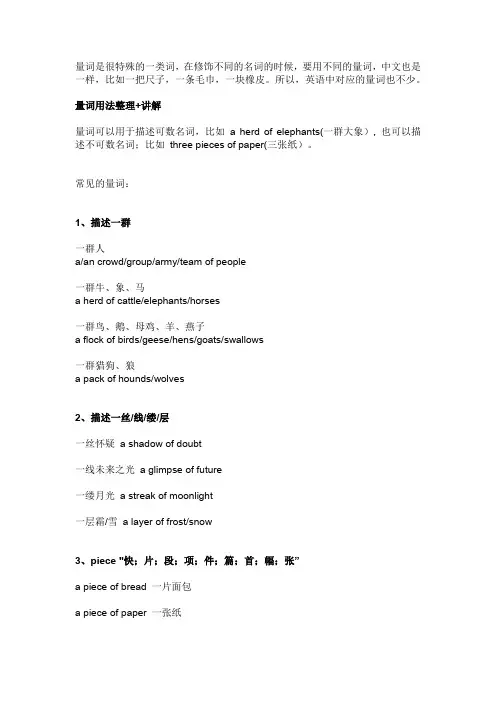
量词是很特殊的一类词,在修饰不同的名词的时候,要用不同的量词,中文也是一样,比如一把尺子,一条毛巾,一块橡皮。
所以,英语中对应的量词也不少。
量词用法整理+讲解量词可以用于描述可数名词,比如 a herd of elephants(一群大象), 也可以描述不可数名词;比如three pieces of paper(三张纸)。
常见的量词:1、描述一群一群人a/an crowd/group/army/team of people一群牛、象、马a herd of cattle/elephants/horses一群鸟、鹅、母鸡、羊、燕子a flock of birds/geese/hens/goats/swallows一群猎狗、狼a pack of hounds/wolves2、描述一丝/线/缕/层一丝怀疑a shadow of doubt一线未来之光a glimpse of future一缕月光a streak of moonlight一层霜/雪 a layer of frost/snow3、piece "快;片;段;项;件;篇;首;幅;张”a piece of bread 一片面包a piece of paper 一张纸a piece of wood 一段木头a piece of furniture 一件家具a piece of land 一块土地a piece of advice 一则建议a piece of news 一篇新闻a piece of meat 一块肉a piece of cloth 一块布料a piece of music 一首曲子4、描述“一阵”一阵哭泣/喝彩/炮击/雷声a burst of tears/cheers/gunfire/thunder一阵瓢泼大雨/夸夸其谈a flood of rain/boasts5、a pair of 后面接由两部分组成的单件事物a pair of glasses 一副眼镜a pair of scissors 一把剪刀a pair of spectacles 一副眼镜a pair of trousers 一条裤子a pair of pants 一条裤子a pair of pliers 一把剪钳其他常用量词a drop of water 一滴水a flood of moonlight 一片月光a flood of light 一大片强光a flood of people 人潮汹涌a flood of words 口若悬河a flood of tears 泪如泉涌a wisp of smoke 一缕烟/一股烟a wisp of a smile 一丝微笑a pane of glass 一块玻璃a layer of rock 一层岩石a cloud of smoke 一团烟雾a beam of light 一束光线a blade of grass 一片草叶a block of wood 一块木头a cube of sugar 一块方糖a roll of newspaper 一卷报纸a cone of ice cream 一个蛋卷冰淇淋a bar of chocolate 一块巧克力a stack of hay 一堆乾草a loaf of bread 一个面包a grain of rice 一粒米a cake of soap 一块肥皂a dash of salt 一撮盐a coil of wire 一卷电线a roll of tobacco 一卷烟草a roll of bread 一块面包a ball of wool 一个毛线球a glimmer of hope 一线希望a thread of hope 一线希望a thread of smoke 一缕青烟a piece of such cord 一根细丝a thread of water 细细的一条流水a mouthful of sweet country air 一口新鲜的乡村空气a handful of corn 一把玉米a handful of people 少数几个人a group of people/trees/houses 一群人/一片树林/一片房子an army of elephants 一群大象a pack / throng of wolves 一群狼a batch of dogs 一群狗a brood of chicks 一群小鸡a hive of bees 一群蜜蜂a host of monkeys 一群猴子a school of fish 一群鱼a swarm of locusts 一群蝗虫a team / field of horses 一群马a gang of elks 一群驼鹿a burst of laughter 一阵笑声a gust of wind 一股风a web of railroad 铁路网a train of thoughts 一连串的想法a nice cup of tea 一杯好茶a thin coat of ice 一层薄冰a stagnant pool of water 一潭死水a beautiful stretch of field 一片美丽的原野a piece of paper 一张纸a piece of information 一条消息an article of clothes 一件衣物a cup of water 一杯水a packet of cigarettes 一盒香烟a basket of vegetables 一篮子蔬菜。
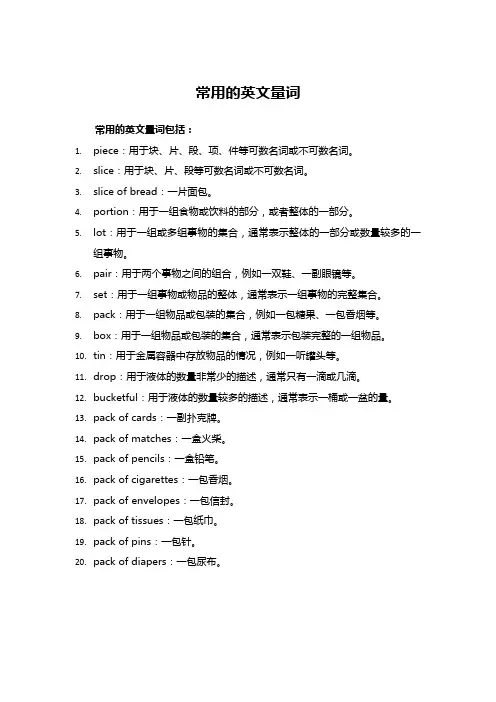
常用的英文量词
常用的英文量词包括:
1.piece:用于块、片、段、项、件等可数名词或不可数名词。
2.slice:用于块、片、段等可数名词或不可数名词。
3.slice of bread:一片面包。
4.portion:用于一组食物或饮料的部分,或者整体的一部分。
5.lot:用于一组或多组事物的集合,通常表示整体的一部分或数量较多的一
组事物。
6.pair:用于两个事物之间的组合,例如一双鞋、一副眼镜等。
7.set:用于一组事物或物品的整体,通常表示一组事物的完整集合。
8.pack:用于一组物品或包装的集合,例如一包糖果、一包香烟等。
9.box:用于一组物品或包装的集合,通常表示包装完整的一组物品。
10.tin:用于金属容器中存放物品的情况,例如一听罐头等。
11.drop:用于液体的数量非常少的描述,通常只有一滴或几滴。
12.bucketful:用于液体的数量较多的描述,通常表示一桶或一盆的量。
13.pack of cards:一副扑克牌。
14.pack of matches:一盒火柴。
15.pack of pencils:一盒铅笔。
16.pack of cigarettes:一包香烟。
17.pack of envelopes:一包信封。
18.pack of tissues:一包纸巾。
19.pack of pins:一包针。
20.pack of diapers:一包尿布。
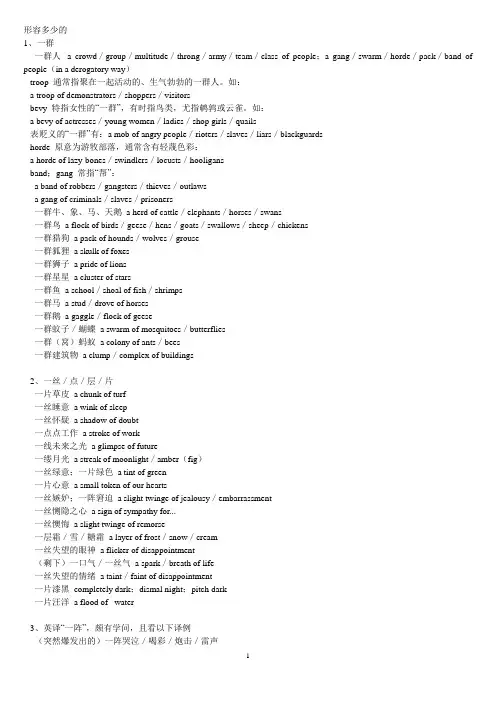
形容多少的1、一群一群人 a crowd/group/multitude/throng/army/team/class of people;a gang/swarm/horde/pack/band of people(in a derogatory way)troop 通常指聚在一起活动的、生气勃勃的一群人。
如:a troop of demonstrators/shoppers/visitorsbevy 特指女性的“一群”,有时指鸟类,尤指鹌鹑或云雀。
如:a bevy of actresses/young women/ladies/shop girls/quails表贬义的“一群”有:a mob of angry people/rioters/slaves/liars/blackguardshorde 原意为游牧部落,通常含有轻蔑色彩:a horde of lazy-bones/swindlers/locusts/hooligansband;gang 常指“帮”:a band of robbers/gangsters/thieves/outlawsa gang of criminals/slaves/prisoners一群牛、象、马、天鹅a herd of cattle/elephants/horses/swans一群鸟a flock of birds/geese/hens/goats/swallows/sheep/chickens一群猎狗a pack of hounds/wolves/grouse一群狐狸a skulk of foxes一群狮子a pride of lions一群星星a cluster of stars一群鱼a school/shoal of fish/shrimps一群马a stud/drove of horses一群鹅a gaggle/flock of geese一群蚊子/蝴蝶a swarm of mosquitoes/butterflies一群(窝)蚂蚁a colony of ants/bees一群建筑物a clump/complex of buildings2、一丝/点/层/片一片草皮a chunk of turf一丝睡意a wink of sleep一丝怀疑a shadow of doubt一点点工作a stroke of work一线未来之光a glimpse of future一缕月光a streak of moonlight/amber(fig)一丝绿意;一片绿色a tint of green一片心意a small token of our hearts一丝嫉妒;一阵窘迫a slight twinge of jealousy/embarrassment一丝恻隐之心a sign of sympathy for...一丝懊悔a slight twinge of remorse一层霜/雪/糖霜a layer of frost/snow/cream一丝失望的眼神a flicker of disappointment(剩下)一口气/一丝气a spark/breath of life一丝失望的情绪a taint/faint of disappointment一片漆黑completely dark;dismal night;pitch dark一片汪洋a flood of water3、英译“一阵”,颇有学问,且看以下译例(突然爆发出的)一阵哭泣/喝彩/炮击/雷声a burst of tears/cheers/gunfire/thunder(量如洪水的)一阵泪雨/瓢泼大雨/夸夸其谈a flood of tears/rain/boasts少量或稀疏的一阵(小)雨/射击a spatter of rain/bullets一阵稀疏的掌声/喝彩a spatter of applause/cheers声响很大的一阵隆隆的炮声/雷声a peal of artillery/thunder突然而猛烈的一阵暴雨/狂风/烈火a gust/blast of rain/wind/flame持续短暂的一阵怒气/激情/咳嗽a fit of anger/passion/coughing一阵呕吐a vomiting fit持续一段时间的一阵厄运/暑热a spell of bad luck/summer heat一阵寒潮a cold spell of weather一阵昏厥a fainting spell(针捻刀刺般的)一阵内疚/牙痛/风湿痛a twinge of remorse/toothache/rheumatism一阵尴尬a twinge of embarrassment(抽搐或颤抖的)一阵痛苦/伤心/咳嗽/激动a spasm of pain/grief/coughing/excitement雹打雨淋般的一阵轰炸/打击/咒骂a hail of bombs/blows/curse一阵弹雨/批评a shower of bullets/criticism更多的例子一阵欢乐an agony of joy一阵子爱意a flush of love一点点工作a stroke of work一阵心脏病发作a stroke of heart attack一点点满足a crumb of satisfaction一种混乱的政治局面a chaos of politics4、“一阵”为何有这么多不同的译法其实原因很简单,汉语“一阵”这个数量词不含修辞色彩,可用于各类描述;而在英语中,“一阵”这个概念则是由许多不同的名词来表述的,而且这些词一般分别具有不同的修辞色彩。
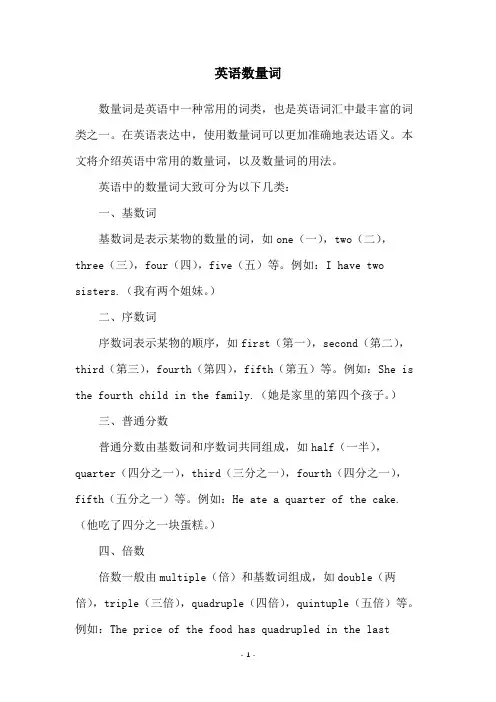
英语数量词数量词是英语中一种常用的词类,也是英语词汇中最丰富的词类之一。
在英语表达中,使用数量词可以更加准确地表达语义。
本文将介绍英语中常用的数量词,以及数量词的用法。
英语中的数量词大致可分为以下几类:一、基数词基数词是表示某物的数量的词,如one(一),two(二),three(三),four(四),five(五)等。
例如:I have two sisters.(我有两个姐妹。
)二、序数词序数词表示某物的顺序,如first(第一),second(第二),third(第三),fourth(第四),fifth(第五)等。
例如:She is the fourth child in the family.(她是家里的第四个孩子。
)三、普通分数普通分数由基数词和序数词共同组成,如half(一半),quarter(四分之一),third(三分之一),fourth(四分之一),fifth(五分之一)等。
例如:He ate a quarter of the cake.(他吃了四分之一块蛋糕。
)四、倍数倍数一般由multiple(倍)和基数词组成,如double(两倍),triple(三倍),quadruple(四倍),quintuple(五倍)等。
例如:The price of the food has quadrupled in the lastmonth.(食物的价格在上个月翻了四倍。
)五、集合数量词集合数量词是形容整体的数量之用,如pair(一对),dozen (一打),score(二十),hundred(一百),thousand(一千)等。
例如:We bought two dozen eggs.(我们买了两打鸡蛋。
)六、计量计量数量词是用来表示重量、距离、面积等的词语,如ton (吨),pound(磅),ounce(盎司),foot(英尺),meter(米)等。
例如:This truck is loaded with five tons of steel.(这辆卡车装载着五吨钢铁。
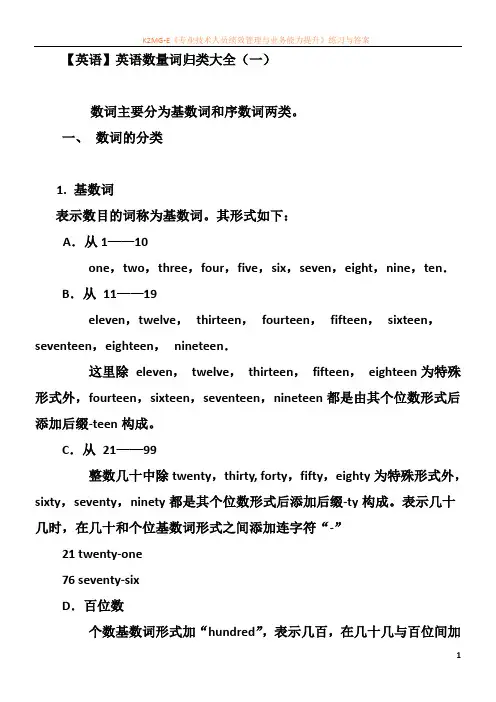
【英语】英语数量词归类大全(一)数词主要分为基数词和序数词两类。
一、数词的分类1. 基数词表示数目的词称为基数词。
其形式如下:A.从1——10one,two,three,four,five,six,seven,eight,nine,ten.B.从11——19eleven,twelve,thirteen,fourteen,fifteen,sixteen,seventeen,eighteen,nineteen.这里除eleven,twelve,thirteen,fifteen,eighteen为特殊形式外,fourteen,sixteen,seventeen,nineteen都是由其个位数形式后添加后缀-teen构成。
C.从21——99整数几十中除twenty,thirty, forty,fifty,eighty为特殊形式外,sixty,seventy,ninety都是其个位数形式后添加后缀-ty构成。
表示几十几时,在几十和个位基数词形式之间添加连字符“-”21 twenty-one76 seventy-sixD.百位数个数基数词形式加“hundred”,表示几百,在几十几与百位间加上and.101 a hundred and one320 three hundred and twenty648 six hundred and forty-eightE.千位数以上从数字的右端向左端数起,每三位数加一个逗号“,”。
从右开始,第一个“,”前的数字后添加thousand,第二个“,”前面的数字后添加million,第三个“,”前的数字后添加billion。
然后一节一节分别表示,两个逗号之间最大的数为百位数形式。
2,648 two thousand six hundred andforty-eight16,250,064 sixteen million two hundred and fiftythousand sixty-four5,237,166,234 five billion,two hundred and thirty-seven million,one hundred and sixty-sixthousand,two hundred and thirty-fourF.基数词在表示确切的数字时,不能使用百、千、百万、十亿的复数形式;但是,当基数词表示不确切数字,如成百、成千上万,三三两两时,基数词则以复数形式出现。
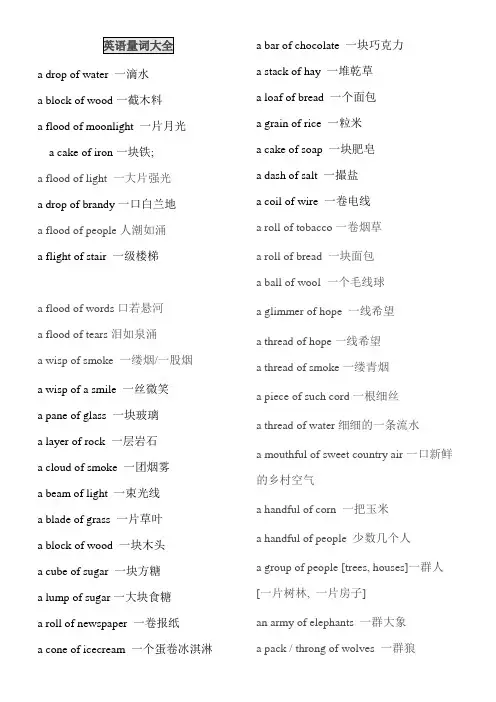
a drop of water 一滴水a block of wood一截木料a flood of moonlight 一片月光a cake of iron一块铁;a flood of light 一大片强光a drop of brandy一口白兰地a flood of people人潮如涌a flight of stair 一级楼梯a flood of words口若悬河a flood of tears泪如泉涌a wisp of smoke 一缕烟/一股烟a wisp of a smile 一丝微笑a pane of glass 一块玻璃a layer of rock 一层岩石a cloud of smoke 一团烟雾a beam of light 一束光线a blade of grass 一片草叶a block of wood 一块木头a cube of sugar 一块方糖a lump of sugar一大块食糖a roll of newspaper 一卷报纸a cone of icecream 一个蛋卷冰淇淋a bar of chocolate 一块巧克力a stack of hay 一堆乾草a loaf of bread 一个面包a grain of rice 一粒米a cake of soap 一块肥皂a dash of salt 一撮盐a coil of wire 一卷电线a roll of tobacco一卷烟草a roll of bread 一块面包a ball of wool 一个毛线球a glimmer of hope 一线希望a thread of hope一线希望a thread of smoke一缕青烟a piece of such cord一根细丝a thread of water细细的一条流水a mouthful of sweet country air一口新鲜的乡村空气a handful of corn 一把玉米a handful of people 少数几个人a group of people [trees, houses]一群人[一片树林, 一片房子]an army of elephants 一群大象a pack / throng of wolves 一群狼a batch of dogs 一群狗a brood of chicks 一群小鸡a hive of bees 一群蜜蜂a host of monkeys 一群猴子a school of fish 一群鱼a swarm of locusts 一群蝗虫a team / field of horses一群马a gang of elks 一群驼鹿a burst of laughter 一阵笑声a gust of wind 一股风a web of railroad 铁路网a train of thoughts 一连串的想法a nice cup of tea 一杯好茶a thin coat of ice 一层薄冰a stagnant pool of water 一潭死水a beautiful stretch of field 一片美丽的原野a pair of glasses 一副眼镜a pair of scissors 一把剪刀a pair of pliers一把钳子a pair of spectacles 一副眼镜a pair of trousers 一条裤子a pair of shoes一双鞋a pair of pant 一条裤子a pair of dancers一对舞伴a pair of stairs一段楼梯a pair of pliers 一把剪钳a piece of paper 一张纸a sheet of paper一张纸a piece of information 一条消息an article of clothes 一件衣物a cup of water 一杯水a packet of cigarettes 一盒香烟a basket of vegetables 一篮子蔬菜a slice of meat一片肉1. 用形状作量词a bar of chocolate一块儿巧克力;a bar of candy一块儿糖;a blade of glass一块儿玻璃;a blade of grass一片儿草叶a block of ice一块儿冰块;a block of wood一截木料a cake of soap一块儿肥皂;a cake of iron一块铁;a drop of water 一滴水;a drop of brandy一口白兰地an ear of flower 一朵花儿;an ear of wheat一穗麦子a flight of stair 一级楼梯a grain of sand一粒沙子a loaf of bread一片面包a lump of sugar一大块食糖a sheet of paper一张纸a slice of meat一片肉a stick of chalk一支粉笔2. 用打包方法做量词a bunch of flowers一束花a bundle of sticks一捆木棍a cluster of roses; 一从玫瑰a pack of cigarettes; 一包香烟a series of films; 一部影片a tuft of hair一束头发3. 用群体作量词an army of soldiers一群士兵a band of musicians一伙音乐家a batch of students一批学生a bench of examiners一行考官a crew of sailors一队海员a crowd of people一群人a gang of thieves一帮小偷a group of children一伙儿儿童a team of players一队选手4. 用畜群作量词a brood of chickens一窝小鸡a clusters of ants一群蚂蚁a herd of cattle一群家畜a pack of wolves一群狼a school of fish一群鱼a swarm of bees一群蜜蜂5. 用度量作量词a foot of一英尺… ;a meter of一米…;a yard of一码…a gram of一克…;a kilo of一公斤…;an ounce of一盎司…;a pound of一磅…;a ton of一吨…a gallon of 一加仑…;a gill of 一及耳…;a liter of 一公升…;a Pint of 一品脱…;a quart of 一夸脱…an area of 一亩;a hectare of一公顷…6. 用容器作量词a bottle of 一瓶…;a bowl of 一碗…a bucket of一桶;a cup of一杯…;a can of一桶儿…;a glass of一玻璃杯…;a jar of一罐儿…7. 用行为动作等作量词a display of courage一股勇气;a fit of laughter一阵笑声a flash of hope一丝希望a peal of thunder一声响雷a ray of light一束光线。
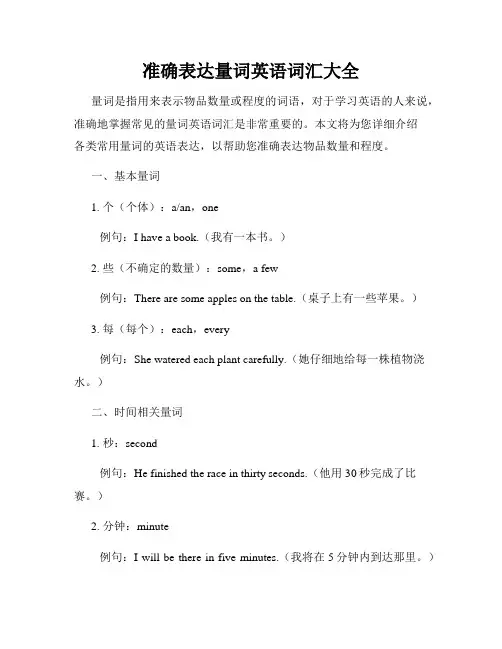
准确表达量词英语词汇大全量词是指用来表示物品数量或程度的词语,对于学习英语的人来说,准确地掌握常见的量词英语词汇是非常重要的。
本文将为您详细介绍各类常用量词的英语表达,以帮助您准确表达物品数量和程度。
一、基本量词1. 个(个体):a/an,one例句:I have a book.(我有一本书。
)2. 些(不确定的数量):some,a few例句:There are some apples on the table.(桌子上有一些苹果。
)3. 每(每个):each,every例句:She watered each plant carefully.(她仔细地给每一株植物浇水。
)二、时间相关量词1. 秒:second例句:He finished the race in thirty seconds.(他用30秒完成了比赛。
)2. 分钟:minute例句:I will be there in five minutes.(我将在5分钟内到达那里。
)3. 小时:hour例句:The movie lasted for two hours.(电影持续了两个小时。
)4. 天:day例句:Tomorrow will be a sunny day.(明天将是一个晴朗的日子。
)5. 星期/周:week例句:We are going on a vacation next week.(我们下周要去度假。
)6. 月:month例句:She will turn 30 next month.(下个月她将年满30岁。
)7. 年:year例句:They got married last year.(他们去年结婚了。
)三、数量量词1. 一些(不确定的数量):some,a few例句:I need some pens.(我需要一些钢笔。
)2. 大量的:a lot of,lots of,plenty of例句:There are a lot of books on the shelf.(书架上有很多书。
1、一群一群人 a crowd/group/multitude/throng/army/team/class of people;a gang/swarm/horde/pack/band of people(in a derogatory way)troop 通常指聚在一起活动的、生气勃勃的一群人。
如:a troop of demonstrators/shoppers/visitorsbevy 特指女性的“一群”,有时指鸟类,尤指鹌鹑或云雀。
如:a bevy of actresses/young women/ladies/shop girls/quails表贬义的“一群”有:a mob of angry people/rioters/slaves/liars/blackguards horde 原意为游牧部落,通常含有轻蔑色彩:a horde of lazy-bones/swindlers/locusts/hooligansband;gang 常指“帮”:a band of robbers/gangsters/thieves/outlawsa gang of criminals/slaves/prisoners一群牛、象、马、天鹅 a herd of cattle/elephants/horses/swans一群鸟 a flock of birds/geese/hens/goats/swallows/sheep/chickens一群猎狗 a pack of hounds/wolves/grouse一群狐狸 a skulk of foxes一群狮子 a pride of lions一群星星 a cluster of stars一群鱼 a school/shoal of fish/shrimps一群马 a stud/drove of horses一群鹅 a gaggle/flock of geese一群蚊子/蝴蝶 a swarm of mosquitoes/butterflies一群(窝)蚂蚁 a colony of ants/bees一群建筑物 a clump/complex of buildings2、一丝/点/层/片一片草皮 a chunk of turf一丝睡意 a wink of sleep一丝怀疑 a shadow of doubt一点点工作 a stroke of work一线未来之光 a glimpse of future一缕月光 a streak of moonlight/amber(fig)一丝绿意;一片绿色 a tint of green一片心意 a small token of our hearts一丝嫉妒;一阵窘迫 a slight twinge of jealousy/embarrassment一丝恻隐之心 a sign of sympathy for...一丝懊悔 a slight twinge of remorse一层霜/雪/糖霜 a layer of frost/snow/cream一丝失望的眼神 a flicker of disappointment(剩下)一口气/一丝气 a spark/breath of life一丝失望的情绪 a taint/faint of disappointment一片漆黑completely dark;dismal night;pitch dark一片汪洋 a flood of water3、英译“一阵”,颇有学问,且看以下译例(突然爆发出的)一阵哭泣/喝彩/炮击/雷声a burst of tears/cheers/gunfire/thunder(量如洪水的)一阵泪雨/瓢泼大雨/夸夸其谈a flood of tears/rain/boasts少量或稀疏的一阵(小)雨/射击 a spatter of rain/bullets一阵稀疏的掌声/喝彩 a spatter of applause/cheers声响很大的一阵隆隆的炮声/雷声 a peal of artillery/thunder突然而猛烈的一阵暴雨/狂风/烈火 a gust/blast of rain/wind/flame持续短暂的一阵怒气/激情/咳嗽 a fit of anger/passion/coughing一阵呕吐 a vomiting fit持续一段时间的一阵厄运/暑热 a spell of bad luck/summer heat一阵寒潮 a cold spell of weather一阵昏厥 a fainting spell(针捻刀刺般的)一阵内疚/牙痛/风湿痛 a twinge of remorse/toothache/rheumatism一阵尴尬 a twinge of embarrassment(抽搐或颤抖的)一阵痛苦/伤心/咳嗽/激动 a spasm of pain/grief/coughing /excitement雹打雨淋般的一阵轰炸/打击/咒骂 a hail of bombs/blows/curse一阵弹雨/批评 a shower of bullets/criticism更多的例子一阵欢乐an agony of joy一阵子爱意 a flush of love一点点工作 a stroke of work一阵心脏病发作 a stroke of heart attack一点点满足 a crumb of satisfaction一种混乱的政治局面 a chaos of politics4、“一阵”为何有这么多不同的译法其实原因很简单,汉语“一阵”这个数量词不含修辞色彩,可用于各类描述;而在英语中,“一阵”这个概念则是由许多不同的名词来表述的,而且这些词一般分别具有不同的修辞色彩。
【英语】英语数量词归类大全(一)数词主要分为基数词和序数词两类。
一、数词的分类1. 基数词表示数目的词称为基数词。
其形式如下:A.从1——10one,two,three,four,five,six,seven,eight,nine,ten.B.从 11——19eleven,twelve, thirteen, fourteen, fifteen,sixteen, seventeen,eighteen, nineteen.这里除 eleven, twelve, thirteen, fifteen,eighteen为特殊形式外,fourteen,sixteen,seventeen,nineteen都是由其个位数形式后添加后缀-teen构成。
C.从 21——99整数几十中除twenty,thirty, forty,fifty,eighty 为特殊形式外,sixty,seventy,ninety都是其个位数形式后添加后缀-ty构成。
表示几十几时,在几十和个位基数词形式之间添加连字符“-”21 twenty-one76 seventy-sixD.百位数个数基数词形式加“hundred”,表示几百,在几十几与百位间加上and.101 a hundred and one320 three hundred and twenty648 six hundred and forty-eightE.千位数以上从数字的右端向左端数起,每三位数加一个逗号“,”。
从右开始,第一个“,”前的数字后添加 thousand,第二个“,”前面的数字后添加 million,第三个“,”前的数字后添加 billion。
然后一节一节分别表示,两个逗号之间最大的数为百位数形式。
2,648 two thousand six hundred andforty-eight16,250,064 sixteen million two hundred and fifty thousand sixty-four5,237,166,234 five billion,two hundred and thirty-sevenmillion,one hundred and sixty-sixthousand,two hundred and thirty-fourF.基数词在表示确切的数字时,不能使用百、千、百万、十亿的复数形式;但是,当基数词表示不确切数字,如成百、成千上万,三三两两时,基数词则以复数形式出现。
常见的英语量词归纳下面是小编整理的一些关于英语常见的量词归纳,希望对大家有帮助。
在英语中,有很多量词词组,例如:a group of,a flock of, a bunch of,a bundle of 等等.本文对量词词组粗略地归纳了以下的特点,具体表现为:特点一:英语量词词组所表示的数或量,大致可归纳为四种类型,即定量、不定量、大量和少量。
1.表示定量的量词词组,譬如:a couple of(两个、一对)—a couple of days,a couple of players,a couple of timesa cupful of(一满杯)—a cupful of jelly,a cupful of watera portion of(一份/客)—a portion of duck,a portion of roast beef2.表示不定量的量词词组,譬如:a majority of(大多数/大半)—a majority of opinions,a majority of votesan atom of(一点)—an atom of food,an atom of trutha spell of(一阵/一段时间)—a spell of fine weather,a spell of coughing3.表示大量的量词词组,譬如:a flood of—a flood of ink(洋洋大篇),a flood of tears(泪如泉涌)a heap of—a heap of earth(一堆泥土),a heap of customers(许多顾客)a mountain of—a mountain of debts(债台高筑),a mountain of difficulties(困难重重)4.表示少量的量词词组,譬如:a drop of—a drop of fever(有点热度),a drop of dew(一点露水)a particle of—a particle of feeling(一丝感情),a particle of dust(一点灰尘)a shadow of—a shadow of doubt(一点怀疑),a shadow of freedom(一点自由)特点二:有些数量词组修饰可数名词,有些数量词组修饰不可数名词,还有些则两者均可修饰。
英语量词大全
英语中有很多量词,用于描述物体、事物的数量或程度。
以下是一些常见的英语量词:
1.通用量词:
a(一个)
an(一个,用于以元音音素开头的单词前)
2.可数名词的量词:
one(一个)
two(两个)
three(三个)
four(四个)
dozen(一打,12个)
hundred(一百)
thousand(一千)
3.不可数名词的量词:
some(一些)
a little(一点)
a lot of(许多)
much(许多,用于否定句和疑问句)
4.时间的量词:
second(秒)
minute(分钟)
hour(小时)
day(天)
week(周)
month(月)
year(年)
5.空间的量词:
nch(英寸)
foot(英尺)
yard(码)
mile(英里)
centimeter(厘米)
meter(米)
kilometer(千米)6货币的量词:
dollar(美元)
pound(英镑)
euro(欧元)
yen(日元)
yuan(人民币)7.重量的量词:
ounce(盎司)
pound(磅)
kilogram(千克)
8.数量词:
many(许多)
few(几个)
several(若干)
all(所有)
这些只是一些基础的量词,实际上英语中有很多其他用于描述数量和程度的词汇。
具体的使用要根据语境和具体情况而定。
英语常用量词词组对于英语的量词大家堵塞了解有多少呢?如果不清楚的,可以看小编的总结哦!接下来,小编给大家准备了英语常用量词词组,欢迎大家参考与借鉴。
英语常用量词词组数量词词组1)a bit 一点儿2)a few (of) 一些(可数),几个……3)a little 一些(不可数)4)a lot of (lots of) 许多5)a piece of 一张(一片,块)6)a cup of 一茶怀7)a glass of 一玻璃杯8)a pile of (piles and piles of) 一堆(一堆堆的)……9)a box of 一盒10)a copy of 一份,一本11)a bowl of 一碗12)a basket of 一篮13)a plate of 一盘14)a bottle of 一瓶15)a basin of 一脸盆16)a set of 一套17)a kind of 一种18)a type of 一种类型的19)a great deal of 非常多,大量的(不可数名词)20)a large (great) number of 非常多,大量的(可数名词)21)a great many 大量,许多(可数名词)22)a different type of 一种不同型号的23)a group of 一队,一组,一群其他词组1)all kinds of 各种各样的2)all over the world/the country 全世界/全国3)all one's life 一生4)one after another 顺次5)the Children's Palace 少年宫6)day after day 日复一日7)up and down 上上下下8)the day after tomorrow 后天9)the day before yesterday 前天10)the last/past two years (or so) 最近两年(左右)11)the whole country/the whole world 全国/全世界12)a moment ago 刚才13)just now/then 刚才/那时14)half an hour's walk 步行半小时的路程15)late on 过后,后来扩展:一定要看-初中过去进行时态精讲一、概念和用法:1) 概念:表示过去某时正在进行的状态或动作。
【英语】英语数量词归类大全(一)数词主要分为基数词和序数词两类。
一、数词的分类1.基数词表示数目的词称为基数词。
其形式如下:A.从1——10one,two,three,four,five,siR,seven,eight,nine,ten.B.从11——19eleven,twelve,thirteen,fourteen,fifteen,siRteen,seventeen,eighteen,nineteen.这里除eleven,twelve,thirteen,fifteen,eighteen为特殊形式外,fourteen,siRteen,seventeen,nineteen都是由其个位数形式后添加后缀-teen构成。
C.从21——99整数几十中除twentR,thirtR,fortR,fiftR,eightR为特殊形式外,siRtR,seventR,ninetR都是其个位数形式后添加后缀-tR构成。
表示几十几时,在几十和个位基数词形式之间添加连字符“-”21twentR-one76seventR-siRD.百位数个数基数词形式加“hundred”,表示几百,在几十几与百位间加上and.101ahundredandone320threehundredandtwentR648siRhundredandfortR-eightE.千位数以上从数字的右端向左端数起,每三位数加一个逗号“,”。
从右开始,第一个“,”前的数字后添加thousand,第二个“,”前面的数字后添加million,第三个“,”前的数字后添加billion。
然后一节一节分别表示,两个逗号之间最大的数为百位数形式。
2,648twothousandsiRhundredandfortR-eight16,250,064siRteenmilliontwohundredandfiftR thousandsiRtR-four5,237,166,234fivebillion,twohundredandthirtR-seven million,onehundredandsiRtR-siRthousand,twohundredandthirtR-fourF.基数词在表示确切的数字时,不能使用百、千、百万、十亿的复数形式;但是,当基数词表示不确切数字,如成百、成千上万,三三两两时,基数词则以复数形式出现。
英语数量词归类大全
数词主要分为基数词和序数词两类。
一、数词的分类
1. 基数词
表示数目的词称为基数词。
其形式如下:
A.从1——10
one,two,three,four,five,six,seven,eight,nine,ten.
B.从11——19
eleven,twelve,thirteen,fourteen,fifteen,sixteen,seventeen,eighteen,nineteen.
这里除eleven,twelve,thirteen,fifteen,eighteen为特殊形式外,fourteen,sixteen,seventeen,nineteen都是由其个位数形式后添加后缀-teen构成。
C.从21——99
整数几十中除twenty,thirty, forty,fifty,eighty为特殊形式外,sixty,seventy,ninety 都是其个位数形式后添加后缀-ty构成。
表示几十几时,在几十和个位基数词形式之间添加连字符“-”
21 twenty-one
76 seventy-six
D.百位数
个数基数词形式加“hundred”,表示几百,在几十几与百位间加上and.
101 a hundredand one
320 threehundred and twenty
648 sixhundred and forty-eight
E.千位数以上
从数字的右端向左端数起,每三位数加一个逗号“,”。
从右开始,第一个“,”前的数字后添加thousand,第二个“,”前面的数字后添加million,第三个“,”前的数字后添加billion。
然后一节一节分别表示,两个逗号之间最大的数为百位数形式。
2,648 twothousand six hundred and forty-eight
16,250,064sixteen million two hundred and fifty thousand sixty-four
5,237,166,234five billion,twohundred and thirty-seven million,one hundred and sixty-six thousand,two hundred and thirty-four
F.基数词在表示确切的数字时,不能使用百、千、百万、十亿的复数形式;但是,当基数词表示不确切数字,如成百、成千上万,三三两两时,基数词则以复数形式出现。
There arehundreds of people in the hall.大厅里有数以百计的人。
Thousands andthousands of people come to visit the Museum of Qin Terra-Cotta Warriors and Horses every day.每天有成千上万的人来参观秦兵马涌博物馆。
They went tothe theatre in twos and threes.他们三三两两地来到了剧院。
G.表示人的不确切岁数或年代,用几十的复数形式表示。
He became aprofessor in his thirties.他三十多岁时成为了教授。
She died oflung cancer in forties.她四十来岁时死于肺癌。
It was in the1960s.那是在二十世纪六十年代。
H.基数词的句法功能
基数词在句中可作主语、宾语、定语、表语、同位语。
The twohappily opened the box.两个人高兴地打开了盒子。
(作主语)
I need threealtogether.我总共需要三个。
(作宾语)
Four studentsare playing volleyball outside.四个学生在外面打排球。
(作定语)
We are sixteen.我们16岁。
(作表语)
They threetried to finish the task before sunset.他们三个人尽力想在日落前完成任务。
(作同位语)
2. 序数词
表示顺序的词称为序数词。
序数词的主要形式:
A.从第一至第十九
其中one— first,two— second,three— third,five— fifth,eight—eighth,nine—ninth,twelve— twelfth为特殊形式,其它的序数词都是由其相对应的基数词后面添加“th”构成。
例如:six— sixth,nineteen— nineteenth。
B.从第二十至第九十九
整数第几十的形式由其对应的基数词改变结尾字母y为i,再加“eth”构成。
twenty——twentieth,thirty——thirtieth
表示第几十几时,用几十的基数词形式加上连字符“-”和个位序数词形式一起表示。
thirty-first 第三十一
fifty-sixth 第五十六
seventy-third 第七十三
ninety-ninth 第九十九
C.第一百以上的多位序数词
由基数词的形式变结尾部分为序数词形式来表示。
one hundredand twenty-first 第一百二十一
one thousand,three hundred and twentieth 第一千三百二十
D.序数词的缩写形式
有时序数词可以用缩写形式来表示。
主要缩写形式有。
first——lst ,second——2nd ,third——3rd,fourth——4th,sixth——6th ,twentieth——20th,
twenty-third——23rd
其中lst,2nd,3rd为特殊形式,其它的都是阿拉伯数字后加上-th。
E.序数词的句法功能
序数词在句中可作主语、宾语、定语和表语。
The second iswhat I really need.第二个是我真正需要的。
(作主语)
He choose thesecond.他挑选了第二个。
(作宾语)
We are tocarry out the first plan.我们将执行第一个计划。
(作定语)
She is thesecond in our class.在我们班她是第二名。
(作表语)
注:序数词在使用时,通常前面要加定冠词the;但是如果序数词前出现不定冠词a或an时,则表示“再——”,“又——”。
We’ll go overit a second time.
我们得再念第二遍。
We’ve tried itthree times.Mustwe try it a fourth time?
我们已经试过三遍了,还必须试一次(第四次)吗?
另外,基数词也可以表示顺序。
只需将基数词放在它所修饰的名词之后即可,不需要添加定冠词。
the firstlesson——Lesson One
the fifthpage——Page 5
thetwenty-first room——Room 21
二、时刻表示法
1. 表示几点钟用基数词加可以省略的o’clock
5:00 读作five o’clock 或five
2. 表示几点过几分,在分钟后加past,再加小时
five pastseven 七点过五分
half past six 六点半
a quarter pasteight 八点过一刻
seven pasteight 八点过七分
3. 表示几点差几分,在分钟后面加to,再加小时
ten to eight 差十分八点(七点五十分)
a quarter totwelve 差一刻十二点(十一点四十五分)
twenty to six 差二十分六点(五点四十分)
在日常生活中,常用下列简单方法表示时间。
以小时、分钟为单位分别读出数字。
6:31读作six thirty-one
10:26读作ten twenty-six
14:03 读作fourteen o three
16:15 读作sixteen fifteen
18:30 读作eighteen thirty
23:55 读作twenty-three fifty-five
注:时刻表上的时间大多采用24小时表示法,这样就不需要用a.m.表示上午,p.m.表示下午了。